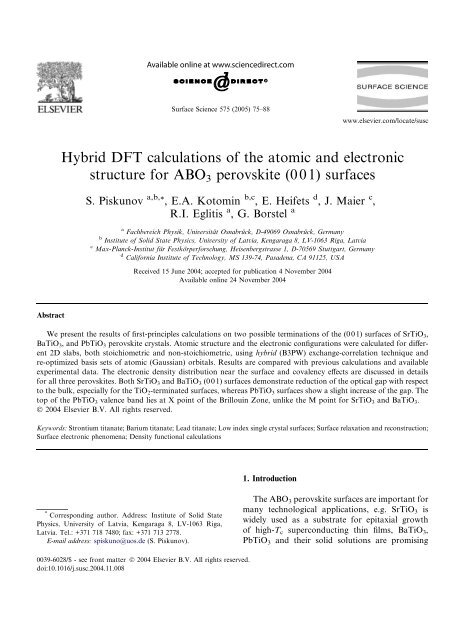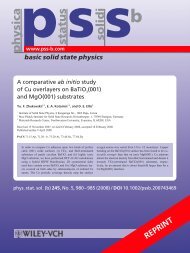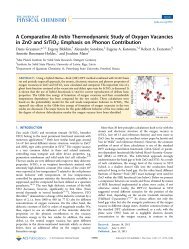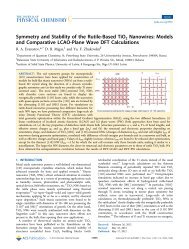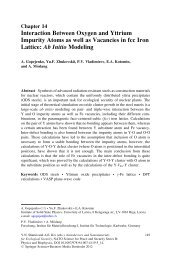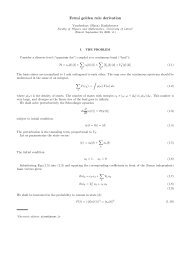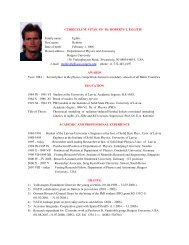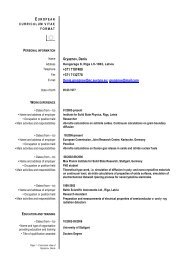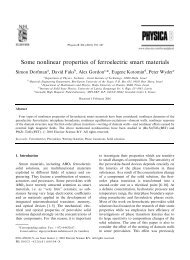View - Institute of Solid State Physics (ISSP), Riga, Latvia
View - Institute of Solid State Physics (ISSP), Riga, Latvia
View - Institute of Solid State Physics (ISSP), Riga, Latvia
Create successful ePaper yourself
Turn your PDF publications into a flip-book with our unique Google optimized e-Paper software.
Surface Science 575 (2005) 75–88<br />
www.elsevier.com/locate/susc<br />
Hybrid DFT calculations <strong>of</strong> the atomic and electronic<br />
structure for ABO 3 perovskite (001) surfaces<br />
S. Piskunov a,b, *, E.A. Kotomin b,c , E. Heifets d , J. Maier c ,<br />
R.I. Eglitis a , G. Borstel a<br />
a Fachbereich Physik, Universität Osnabrück, D-49069 Osnabrück, Germany<br />
b <strong>Institute</strong> <strong>of</strong> <strong>Solid</strong> <strong>State</strong> <strong>Physics</strong>, University <strong>of</strong> <strong>Latvia</strong>, Kengaraga 8, LV-1063 <strong>Riga</strong>, <strong>Latvia</strong><br />
c Max-Planck-Institut für Festkörperforschung, Heisenbergstrasse 1, D-70569 Stuttgart, Germany<br />
d California <strong>Institute</strong> <strong>of</strong> Technology, MS 139-74, Pasadena, CA 91125, USA<br />
Received 15 June 2004; accepted for publication 4 November 2004<br />
Available online 24 November 2004<br />
Abstract<br />
We present the results <strong>of</strong> first-principles calculations on two possible terminations <strong>of</strong> the (001) surfaces <strong>of</strong> SrTiO 3 ,<br />
BaTiO 3 , and PbTiO 3 perovskite crystals. Atomic structure and the electronic configurations were calculated for different<br />
2D slabs, both stoichiometric and non-stoichiometric, using hybrid (B3PW) exchange-correlation technique and<br />
re-optimized basis sets <strong>of</strong> atomic (Gaussian) orbitals. Results are compared with previous calculations and available<br />
experimental data. The electronic density distribution near the surface and covalency effects are discussed in details<br />
for all three perovskites. Both SrTiO 3 and BaTiO 3 (001) surfaces demonstrate reduction <strong>of</strong> the optical gap with respect<br />
to the bulk, especially for the TiO 2 -terminated surfaces, whereas PbTiO 3 surfaces show a slight increase <strong>of</strong> the gap. The<br />
top <strong>of</strong> the PbTiO 3 valence band lies at X point <strong>of</strong> the Brillouin Zone, unlike the M point for SrTiO 3 and BaTiO 3 .<br />
Ó 2004 Elsevier B.V. All rights reserved.<br />
Keywords: Strontium titanate; Barium titanate; Lead titanate; Low index single crystal surfaces; Surface relaxation and reconstruction;<br />
Surface electronic phenomena; Density functional calculations<br />
1. Introduction<br />
* Corresponding author. Address: <strong>Institute</strong> <strong>of</strong> <strong>Solid</strong> <strong>State</strong><br />
<strong>Physics</strong>, University <strong>of</strong> <strong>Latvia</strong>, Kengaraga 8, LV-1063 <strong>Riga</strong>,<br />
<strong>Latvia</strong>. Tel.: +371 718 7480; fax: +371 713 2778.<br />
E-mail address: spiskuno@uos.de (S. Piskunov).<br />
The ABO 3 perovskite surfaces are important for<br />
many technological applications, e.g. SrTiO 3 is<br />
widely used as a substrate for epitaxial growth<br />
<strong>of</strong> high-T c superconducting thin films, BaTiO 3 ,<br />
PbTiO 3 and their solid solutions are promising<br />
0039-6028/$ - see front matter Ó 2004 Elsevier B.V. All rights reserved.<br />
doi:10.1016/j.susc.2004.11.008
76 S. Piskunov et al. / Surface Science 575 (2005) 75–88<br />
for non-volatile memory cells, as electro-optical<br />
materials, and for piezoelectrical devices [1–4].<br />
Due to intensive development and progressive<br />
miniaturization <strong>of</strong> electronic devices, the electronic<br />
properties and atomic structure <strong>of</strong> the ABO 3<br />
perovskite thin films were extensively studied during<br />
the last years. The SrTiO 3 (001) surface structure<br />
has been analyzed by means <strong>of</strong> low energy<br />
electron diffraction (LEED) [5], reflection high<br />
energy electron diffraction (RHEED), X-ray photoelectron<br />
spectroscopy (XPS) and ultraviolet electron<br />
spectroscopy (UPS) [6], medium energy ion<br />
scattering (MEIS) [7], and surface X-ray diffraction<br />
(SXRD) [8]. The most recent experimental<br />
studies on the SrTiO 3 (001) include a combination<br />
<strong>of</strong> XPS, LEED, and time-<strong>of</strong>-flight scattering and<br />
recoiling spectrometry (TOF-SARS) [9], and UPS<br />
and metastable impact electron spectroscopy<br />
(MIES) [10]. The BaTiO 3 and PbTiO 3 surfaces<br />
are less studied.<br />
The first ab initio calculations <strong>of</strong> the ABO 3<br />
perovskite surfaces has been presented by Kimura<br />
et al. in 1995 [11]. Since then a number <strong>of</strong> calculations<br />
were performed, using different methods,<br />
e.g. linearized augmented plane waves (LAPW)<br />
[12,13], PW ultras<strong>of</strong>t-pseudopotential [14–17],<br />
and Hartree–Fock (HF) [18]. Recently, new studies<br />
on the SrTiO 3 (001) surface relaxation were performed<br />
using density functional theory (DFT) with<br />
plane wave (PW) basis set (DFT-PW method) [19],<br />
and classical shell model (SM) [20,21]. It is wellknown<br />
that DFT considerably underestimate the<br />
band gap. On the other hand, band gap obtained<br />
through the HF calculations is usually overestimated<br />
[22]. To solve this problem, the functionals<br />
containing ‘‘hybrid’’ <strong>of</strong> the non-local HF exchange,<br />
DFT exchange, and generalized gradient approximation<br />
(GGA) correlation functionals, known as<br />
B3LYP and B3PW could be used. These functionals<br />
are quite popular in quantum chemistry <strong>of</strong> molecules<br />
[23,24]. Recently, periodic-structure hybrid<br />
DFT calculations were carried out for a wide range<br />
<strong>of</strong> crystalline materials [25], including perovskites<br />
and their surfaces [26,27]. In all cases the hybrid<br />
functional technique shows the best agreement<br />
with experimental data for both bulk geometry<br />
and optical properties <strong>of</strong> materials under investigation.<br />
In this paper, we continue our recent theoretical<br />
studies <strong>of</strong> the surfaces <strong>of</strong> perovskite materials.<br />
Our studies were carried out using both semiempirical<br />
SM [28] and ab initio HF and DFT methods<br />
[27,29–31] and were dedicated mostly to the<br />
SrTiO 3 (001) surfaces. We studied the effects <strong>of</strong> different<br />
type <strong>of</strong> Hamiltonians (varied from DFT-<br />
LDA to HF with a posteriori corrections) on<br />
surface properties and atomic structure. This analysis<br />
allowed us to choose the B3PW functional for<br />
calculations <strong>of</strong> bulk properties <strong>of</strong> all three perovskites<br />
under consideration [26] as well as <strong>of</strong> their surface<br />
properties [27]. Therefore, B3PW is adopted in<br />
present study to compare atomic structure and<br />
electronic properties <strong>of</strong> the (001) surfaces <strong>of</strong> three<br />
similar perovskites, SrTiO 3 , BaTiO 3 , and PbTiO 3 .<br />
In our simulations, the (001) surfaces <strong>of</strong> perovskites<br />
are modelled using a single slab model.<br />
The paper is organized as follows: in Section 2<br />
we present the technical details <strong>of</strong> calculations.<br />
In Section 3 we discuss the surface structure and<br />
the electronic properties <strong>of</strong> the (001) surfaces.<br />
Our conclusions are summarized in Section 4.<br />
2. Computational details<br />
To perform the first-principles DFT-B3PW calculations,<br />
we used the CRYSTAL-98 computer<br />
code [22,32–34]. This code employs the Gaussian-type<br />
functions (GTF) localized at atoms as<br />
the basis for an expansion <strong>of</strong> the crystalline orbitals.<br />
Features <strong>of</strong> the CRYSTAL code, which are<br />
most important for this study, are its ability to calculate<br />
the electronic structure <strong>of</strong> materials within<br />
both HF and Kohn–Sham (KS) Hamiltonians<br />
and implementation <strong>of</strong> isolated 2D slab model<br />
without its artificial repetition along the z-axis.<br />
However, in order to employ the LCAO-GTF<br />
method, it is desirable to have optimized basis sets<br />
(BS). Such BSÕs optimization for all three perovskites<br />
was developed and discussed in Ref. [26]. In<br />
this paper, we used this new BS which differs from<br />
our previous calculations [27,29–31] by inclusion<br />
<strong>of</strong> polarizable d-orbitals on O ions. We demonstrated<br />
that this leads to better agreement <strong>of</strong> calculated<br />
optical gaps with experimental data.<br />
Our calculations were performed using the hybrid<br />
exchange-correlation B3PW functional involv-
S. Piskunov et al. / Surface Science 575 (2005) 75–88 77<br />
ing a hybrid <strong>of</strong> non-local Fock exact exchange,<br />
LDA exchange and BeckeÕs gradient corrected exchange<br />
functional [35], combined with the nonlocal<br />
gradient corrected correlation potential by<br />
Perdew and Wang [36–38]. The Hay–Wadt smallcore<br />
effective core pseudopotentials (ECP) were<br />
adopted for Ti, Sr, and Ba atoms [39–41]. The<br />
‘‘small-core’’ ECPÕs replace only inner core orbitals,<br />
but orbitals for sub-valence electrons as<br />
well as for valence electrons are calculated selfconsistently.<br />
Light oxygen atoms were treated with<br />
the all-electron BS. The BSs were adopted in the<br />
following forms: O—8-411(1d)G, Ti—411(311d)G,<br />
Sr and Ba—311(1d)G; see Ref. [26] for more<br />
details.<br />
The reciprocal space integration was performed<br />
by the sampling the Brillouin zone <strong>of</strong> the unit cell<br />
with the 8 · 8 · 1 Pack–Monkhorst net [42], that<br />
provides the balanced summation in direct and reciprocal<br />
spaces [43]. To achieve high accuracy,<br />
large enough tolerances <strong>of</strong> 7, 8, 7, 7, 14, were<br />
chosen for the Coulomb overlap, Coulomb penetration,<br />
exchange overlap, the first exchange<br />
pseudo-overlap, and for the second exchange<br />
pseudo-overlap, respectively [32].<br />
The ABO 3 (001) surfaces were modelled with 2D<br />
slabs, consisting several crystal planes perpendicular<br />
to (001) crystal direction. The slabs were rotated<br />
to make them perpendicular to Oz axis. The<br />
CRYSTAL code allowed us to avoid artificial periodicity<br />
along Oz direction and to perform simulations<br />
for stand-alone 2D slabs. The symmetrical<br />
(with respect to the mirror plane) 7-plane slabs<br />
are either AO- or TiO 2 -terminated. These slabs<br />
are non-stoichiometric, with unit cell formulas<br />
A 4 B 3 O 10 and A 3 B 4 O 11 , respectively. An alternative<br />
asymmetrical slab is AO- and TiO 2 -terminated<br />
(from each side, respectively) and stoichiometric<br />
with unit cell formula A 4 B 4 O 12 , as shown schematically<br />
in Fig. 1(top). The slabs containing seven<br />
planes (symmetrical) and eight planes (asymmetrical)<br />
can be treated as thick enough since the convergence<br />
<strong>of</strong> the calculated slab total energy per ABO 3<br />
unit is achieved. The total energies differ less than<br />
5 · 10 4 Hartree when 7- and 9-layered (or 8- and<br />
10-layered for asymmetrical termination) slabs<br />
Fig. 1. On top: schematic view <strong>of</strong> the modelling for ABO 3 (001) surfaces: (a) AO-terminated on both sides, (b) TiO 2 -terminated on<br />
both sides, (c) asymmetrical termination (AO atop and TiO 2 on bottom). On bottom: schematic illustration <strong>of</strong> the relaxation for two<br />
outermost surface layers relaxation: (d) SrTiO 3 , (e) BaTiO 3 , (f) PbTiO 3 . The view in the [010] direction. Left panels in d–f are AO<br />
termination, right panels—TiO 2 . Dashed lines represent positions <strong>of</strong> the same layers in unrelaxed slabs.
78 S. Piskunov et al. / Surface Science 575 (2005) 75–88<br />
are considered. The symmetrical slabs have advantage<br />
<strong>of</strong> no macroscopic dipole moment perpendicular<br />
to the slab. However, their non-stoichiometry<br />
can potentially affect the electronic density distributions<br />
and thus atomic displacements. On the<br />
other hand, since the effective atomic charges <strong>of</strong><br />
Ti and O ions differ from the ionic charges +4e,<br />
2e (due to the covalency contribution in Ti–O<br />
chemical bonding), the alternating TiO 2 and AO<br />
planes are slightly charged, what produces in the<br />
asymmetrical slab certain dipole moment perpendicular<br />
to the slab. This dipole moment is cancelled<br />
by the electronic density redistribution near the surface,<br />
which also can affect the optimized atomic displacements.<br />
That is why a critical comparison <strong>of</strong><br />
these two slab models is important for making reliable<br />
conclusions.<br />
In order to compare properties <strong>of</strong> three perovskites<br />
under the same conditions and to reduce<br />
computational efforts, we consider here only the<br />
high-symmetry cubic (Pm3m) phases <strong>of</strong> these crystals.<br />
The calculated bulk lattice constants (in Å)<br />
are: a = 3.90 for SrTiO 3 , a = 4.01 for BaTiO 3 ,<br />
and a = 3.93 for PbTiO 3 , which demonstrate quite<br />
good agreement with experiment [44,45].<br />
3. Results and discussions<br />
3.1. Surface atomic structure<br />
In present surface structure simulations we allowed<br />
atoms <strong>of</strong> the two outermost surface layers<br />
to relax along the z-axis (surfaces <strong>of</strong> perfect cubic<br />
crystals by symmetry have no forces along the<br />
x- and y-axes). Displacements <strong>of</strong> the third layer<br />
atoms were found negligibly small in our calculations<br />
and thus are not treated. The optimization<br />
Table 1<br />
Atomic displacements with respect to atomic positions on unrelaxed ABO 3 (001) surfaces (in percent <strong>of</strong> bulk lattice constant)<br />
Termination N At. SrTiO 3 BaTiO 3 PbTiO 3<br />
This<br />
study<br />
SM<br />
[28]<br />
LDA<br />
PW [15]<br />
LDA<br />
PW [19]<br />
This<br />
study<br />
SM<br />
[28]<br />
LDA<br />
PW [14]<br />
SM<br />
[20]<br />
LAPW<br />
[13]<br />
This<br />
study<br />
LDA<br />
PW [16]<br />
AO 1 A 4.84 7.10 5.7 6.66 1.99 3.72 2.79 0.72 3.82 4.36<br />
O 0.84 1.15 0.1 1.02 0.63 1.00 1.40 1.09 0.31 0.46<br />
2 Ti 1.75 1.57 1.2 1.79 1.74 1.25 0.92 1.70 3.07 2.39<br />
O 2 0.77 0.87 0.0 0.26 1.40 0.76 0.48 2.75 2.30 1.21<br />
3 A 1.42 1.2 1.54 0.51 0.53 0.69 1.37<br />
O 0.7 0.1 0.26 0.16 0.26 0.28 0.20<br />
TiO 2 1 Ti 2.25 2.96 3.4 1.79 3.08 2.72 3.89 4.14 2.81 3.40<br />
O 2 0.13 1.73 1.6 0.26 0.35 0.94 1.63 2.74 0.31 0.34<br />
2 A 3.55 3.46 2.5 4.61 2.51 2.19 1.31 2.36 5.32 4.53<br />
O 0.57 0.21 0.5 0.77 0.38 0.17 0.62 0.50 1.28 0.43<br />
3 Ti 0.6 0.7 0.26 0.33 0.75 0.81 0.92<br />
O 2 0.29 0.5 0.26 0.01 0.35 0.72 0.27<br />
Asymmetrical 1 A 5.22 2.09 1.8 4.28 4.02<br />
O 0.39 0.69 1.98 3.26 0.24<br />
2 Ti 1.55 1.70 3.01<br />
O 2 0.61 1.50 1.95<br />
– – – – – – –<br />
– – – – – – –<br />
– – – – – – –<br />
7 O 0.64 0.37 1.22<br />
A 3.74 2.54 5.44<br />
8 O 2 0.15 0.34 3.52 2.68 0.74<br />
Ti 2.27 3.03 4.72 4.79 2.84<br />
Symbol A stands for Sr, Ba, or Pb atom. Positive displacements are outwards (to the vacuum), negative displacements mean inward the<br />
slab center.
S. Piskunov et al. / Surface Science 575 (2005) 75–88 79<br />
<strong>of</strong> atomic coordinates was done through the slab<br />
total energy minimization using our own computer<br />
code which implements conjugated gradients optimization<br />
technique [46] with numerical computation<br />
<strong>of</strong> derivatives.<br />
Our calculated atomic displacements are presented<br />
in Table 1 and are schematically illustrated<br />
in Fig. 1(bottom). A comparison with the surface<br />
atomic displacements obtained by other theoretical<br />
calculations is also done in Table 1. The relaxation<br />
<strong>of</strong> surface metal atoms is much larger than that <strong>of</strong><br />
oxygen ions what leads to a considerable rumpling<br />
<strong>of</strong> the outermost plane. Atoms <strong>of</strong> the first surface<br />
layer relax inwards, i.e. towards the bulk. The only<br />
two exceptions are the top oxygen ions <strong>of</strong> SrTiO 3<br />
SrO-terminated and <strong>of</strong> PbTiO 3 TiO 2 -terminated<br />
surfaces. (At the latter point, our calculations disagree<br />
with the DFT-PW-pseudopotential calculations<br />
[16], however the magnitudes <strong>of</strong> calculated<br />
displacements are relative small, 0.31% and<br />
0.34% <strong>of</strong> lattice constant, respectively, which is<br />
close to the limit <strong>of</strong> method accuracy.) The outward<br />
relaxation <strong>of</strong> all atoms in the second layer is found<br />
for all three perovskites and both terminations. The<br />
displacements obtained for asymmetrically terminated<br />
slabs are practically the same as for those<br />
symmetrically terminated. This means that both<br />
symmetrical and asymmetrical slabs are reliable<br />
for the calculations <strong>of</strong> the (001) neutral surfaces.<br />
In order to compare the calculated surface<br />
structures with experimental results, the surface<br />
rumpling s (the relative displacement <strong>of</strong> oxygen<br />
with respect to the metal atom in the surface layer)<br />
and the changes in interlayer distances Dd 12 and<br />
Dd 23 (1, 2, and 3 are the numbers <strong>of</strong> near-surface<br />
layers) are presented in Table 2. Our calculations<br />
<strong>of</strong> the interlayer distances are based on the positions<br />
<strong>of</strong> relaxed metal ions (Fig. 1), which are<br />
known to be much stronger electron scatters than<br />
oxygen ions [5]. Qualitative agreement between all<br />
theoretical methods is observed. The amplitude <strong>of</strong><br />
surface rumpling <strong>of</strong> SrO-terminated SrTiO 3 is predicted<br />
much larger than that for TiO 2 -terminated<br />
SrTiO 3 surface, whereas the rumpling <strong>of</strong> BaTiO 3<br />
TiO 2 -terminated surface is predicted to exceed by<br />
a factor <strong>of</strong> two that for BaO-terminated surface.<br />
Lastly, PbTiO 3 demonstrates practically equal<br />
rumpling for both terminations. From Table 2<br />
one can see that all surfaces show the reduction<br />
<strong>of</strong> interlayer distance d 12 and expansion <strong>of</strong> d 23 .<br />
The calculated surface rumpling agrees quite well<br />
with LEED and RHEED experiments [5,6] (which<br />
are available so far only for SrTiO 3 surfaces).<br />
Theory agrees qualitatively also with the LEED results<br />
for the Dd 12 and Dd 23 . However, the LEED<br />
and RHEED experiments demonstrate that the<br />
topmost oxygen always move outwards the surfaces<br />
whereas all calculations predict for the<br />
Table 2<br />
Calculated and experimental surface rumpling s, and relative displacements <strong>of</strong> the three near-surface planes for the AO- and TiO 2 -<br />
terminated surfaces Dd ij (in percent <strong>of</strong> lattice constant)<br />
AO-terminated<br />
TiO 2 -terminated<br />
s Dd 12 Dd 23 s Dd 12 Dd 23<br />
SrTiO 3 This study 5.66 (5.61) 6.58 ( 6.79) 1.75 (1.55) 2.12 (2.43) 5.79 ( 6.02) 3.55 (3.74)<br />
LDA PW [15] 5.8 6.9 2.4 1.8 5.9 3.2<br />
LDA PW [19] 7.7 8.6 3.3 1.5 6.4 4.9<br />
SM [28] 8.2 8.6 3.0 1.2 6.4 4.0<br />
LEED expt. [5] 4.1 ± 2 5±1 2±1 2.1±2 1±1 1±1<br />
RHEED expt. [6] 4.1 2.6 1.3 2.6 1.8 1.3<br />
BaTiO 3 This study 1.37 (1.40) 3.74 ( 3.79) 1.74 (1.70) 2.73 (2.69) 5.59 ( 5.57) 2.51 (2.54)<br />
LDA PW [14] 1.39 3.71 0.39 2.26 5.2 2.06<br />
SM [20] 0.37 2.42 2.39 1.4 6.5 3.17<br />
SM [28] 4.72 4.97 1.76 1.78 4.91 2.52<br />
PbTiO 3 This study 3.51 (3.78) 6.89 ( 7.03) 3.07 (3.01) 3.12 (3.58) 8.13 ( 8.28) 5.32 (5.44)<br />
LDA PW [16] 3.9 6.75 3.76 3.06 7.93 5.45<br />
Results for asymmetric slabs are given in brackets.
80 S. Piskunov et al. / Surface Science 575 (2005) 75–88<br />
Table 3<br />
Calculated surface energies (in eV per surface cell)<br />
SrTiO 3 BaTiO 3 PbTiO 3<br />
SrO TiO 2 Asymmetrical BaO TiO 2 Asymmetrical PbO TiO 2 Asymmetrical<br />
This study 1.15 1.23 1.19 1.19 1.07 1.13 0.83 0.74 0.85<br />
SM [28] 1.32 1.36 1.45 1.40<br />
LDA PW [19] 1.21 1.19<br />
SM [21] 1.17<br />
LDA PW [16] 1.26 1.24 0.97<br />
Results for previous ab initio calculations [16,19,21] are averaged over AO- and TiO 2 -terminated surfaces.<br />
TiO 2 -terminated SrTiO 3 surface that oxygen goes<br />
inwards. Moreover, Table 2 shows also that LEED<br />
and RHEED experiments contradict each other in<br />
the sign <strong>of</strong> Dd 12 for SrO-terminated surface and<br />
Dd 23 <strong>of</strong> TiO 2 -terminated surface. Up to now the<br />
reason for such discrepancies between the different<br />
experimental data is not clear and still discussed<br />
(e.g. see [15]). Thus, experimental check <strong>of</strong> our predictions<br />
at the moment is prevented by a conflict<br />
between different experimental results. New detailed<br />
experimental studies are important for<br />
resolving this contradiction.<br />
The calculated surface energies <strong>of</strong> the relaxed<br />
surfaces, presented in Table 3, were computed<br />
using the method described in Ref. [29]. The energies<br />
calculated for AO- and TiO 2 -terminated surfaces<br />
demonstrate only a small difference, that<br />
means both terminations could co-exist. Nevertheless,<br />
the energy computed for TiO 2 -terminated<br />
SrTiO 3 surface is a little bit larger than that for<br />
SrO-termination, in contrast to BaTiO 3 and<br />
PbTiO 3 crystals where TiO 2 -terminated surface is<br />
a little bit energetically more favorable.<br />
3.2. Electronic charge redistribution<br />
We begin discussion <strong>of</strong> the electronic structure<br />
<strong>of</strong> surfaces with the analysis <strong>of</strong> charge redistribution<br />
in near-surface planes. The effective atomic<br />
charges (calculated using Mulliken population<br />
analysis) and dipole atomic moments characterizing<br />
atomic deformation along the z-axis are presented<br />
for AO-, TiO 2 -surfaces in Table 4. The<br />
differences in charge densities in the (001) planes<br />
in ABO 3 bulk crystals and on the (001) surfaces<br />
are analyzed in Table 5.<br />
First <strong>of</strong> all, note that the effective charges <strong>of</strong> Sr<br />
and Ba are close to the +2e formal charges,<br />
whereas that <strong>of</strong> Pb is considerably smaller. Ti<br />
and O charges are also much smaller than formal<br />
charges, similarly to the bulk [26], what results<br />
from the Ti–O covalent bonding. The AO-terminated<br />
surfaces <strong>of</strong> SrTiO 3 and BaTiO 3 show similar<br />
behavior. The charges <strong>of</strong> top layer cations are<br />
smaller with respect to the relevant bulk charges,<br />
the oxygen ions attract an additional electron<br />
charge and become more negative. Charges <strong>of</strong><br />
the titanium ions in the second layer are slightly increased.<br />
Oxygen ions in the same layer again became<br />
more negative due to additional electron<br />
charge transfer. Changes in atomic charges in deeper<br />
layers become very small and practically equal<br />
zero in the center <strong>of</strong> the slabs. Unlike SrTiO 3 and<br />
BaTiO 3 , charges <strong>of</strong> the surface oxygen ions on<br />
PbO-terminated surface becomes smaller, Ti in<br />
the second layer shows practically no changes in<br />
the effective charges.<br />
The charge redistribution in the TiO 2 -terminated<br />
surfaces (Table 4) <strong>of</strong> all three perovskites<br />
demonstrates quite similar behavior. All cations<br />
in both topmost layers demonstrate charge reduction.<br />
For surface Ti it is a little bit larger then for<br />
A ions in subsurface layer. Changes <strong>of</strong> charges for<br />
ions in the asymmetrically terminated slabs are<br />
practically the same as for the symmetrically AOterminated<br />
and TiO 2 -terminated slabs, as it should<br />
be when slabs are thick enough and its surfaces<br />
do not interact. However, charge redistribution<br />
makes the ABO 3 (001) surfaces to be polar with<br />
the dipole moment perpendicular to the surface<br />
[47]. Such surfaces are potentially unstable, because<br />
they bear infinite charges or dipole moments
S. Piskunov et al. / Surface Science 575 (2005) 75–88 81<br />
Table 4<br />
The calculated Mulliken effective charges and dipole moments for the AO and TiO 2 terminations<br />
N Ion SrTiO 3 BaTiO 3 PbTiO 3<br />
Q, e d, ea.u. Q, e d, ea.u. Q, e d, ea.u.<br />
AO-terminated surfaces<br />
1 A 1.84 0.22 1.75 0.46 1.28 0.48<br />
( 0.03) ( 0.04) ( 0.07)<br />
O 1.52 0.03 1.47 0.05 1.13 0.02<br />
( 0.12) ( 0.09) (+0.09)<br />
2 Ti 2.36 0.01 2.38 0.01 2.33 0.02<br />
(+0.01) (+0.01) (0.00)<br />
O 2 1.45 0.02 1.42 0.02 1.26 0.01<br />
( 0.04) ( 0.03) ( 0.03)<br />
3 A 1.87 0.02 1.8 0.04 1.35 0.05<br />
(0.00) (+0.01) (+0.01)<br />
O 1.43 0 1.41 0.01 1.26 0.01<br />
( 0.02) ( 0.03) ( 0.03)<br />
4 Ti 2.34 0 2.39 0 2.34 0<br />
( 0.01) (0.00) (+0.01)<br />
O 2 1.41 0 1.39 0 1.23 0<br />
(0.00) ( 0.01) ( 0.01)<br />
TiO 2 -terminated surfaces<br />
1 Ti 2.31 0.08 2.3 0.08 2.28 0.1<br />
( 0.04) ( 0.06) ( 0.06)<br />
O 2 1.32 0.04 1.28 0.02 1.18 0.03<br />
(+0.08) (+0.11) (+0.04)<br />
2 A 1.85 0.04 1.76 0.09 1.27 0.1<br />
( 0.02) ( 0.03) ( 0.07)<br />
O 1.36 0.04 1.34 0.03 1.17 0.01<br />
(+0.05) (+0.04) (+0.06)<br />
3 Ti 2.37 0.01 2.36 0.01 2.33 0.02<br />
(+0.04) (0.00) (0.00)<br />
O 2 1.39 0.02 1.37 0.01 1.2 0.02<br />
(+0.02) (+0.02) (+0.02)<br />
4 A 1.87 0 1.79 0 1.34 0<br />
(0.00) (0.00) ( 0.01)<br />
O 1.4 0 1.38 0 1.22 0<br />
(+0.01) (+0.01) (+0.01)<br />
Numbers in brackets are deviations from bulk values. Bulk charges (in e); SrTiO 3 : Sr = 1.87, Ti = 2.35, O = 1.41, BaTiO 3 : Ba = 1.79,<br />
Ti = 2.36, O = 1.39, PbTiO 3 : Pb = 1.34, Ti = 2.33, O = 1.23 [26].<br />
what cause spurious electric field. As a result <strong>of</strong><br />
self-consistent calculations, the additional charge<br />
densities (Table 5) localized mainly on two upper<br />
layers whereas the central layers practically retain<br />
the bulk charge density. Such the electron charge<br />
density redistribution accompanied by atomic displacements<br />
on the surfaces allows to compensate<br />
the surface dipole moment even for the asymmetrically<br />
terminated slabs. Indeed, as one can see, the<br />
sum <strong>of</strong> changes in charge densities for three topmost<br />
layers <strong>of</strong> the asymmetrically terminated slab<br />
(on both sides) <strong>of</strong> all three perovskites approximately<br />
equals half the charge density <strong>of</strong> the corresponding<br />
bulk plane, which is necessary condition<br />
to remove the macroscopic dipole moment [47].<br />
Both (001) surfaces <strong>of</strong> A II B IV O 3 perovskites
82 S. Piskunov et al. / Surface Science 575 (2005) 75–88<br />
Table 5<br />
Calculated charge densities in the (001) planes in the bulk perovskites (in e, per TiO 2 or AO unit), data are taken from [26]) and in four<br />
top planes <strong>of</strong> the AO-, TiO 2 -terminated and asymmetrical slabs<br />
Termination N Unit SrTiO 3 BaTiO 3 PbTiO 3<br />
Bulk AO 0.46 0.41 0.18<br />
TiO 2 0.46 0.41 0.18<br />
AO 1 AO 0.32 0.28 0.15<br />
( 0.14) ( 0.13) (0.03)<br />
2 TiO 2 0.53 0.46 0.18<br />
( 0.07) ( 0.05) ( 0.06)<br />
3 AO 0.45 0.39 0.1<br />
( 0.02) ( 0.02) ( 0.02)<br />
4 TiO 2 0.49 0.4 0.12<br />
( 0.02) (0.01) (0.00)<br />
TiO 2 1 TiO 2 0.33 0.25 0.08<br />
(0.13) (0.16) (0.03)<br />
2 AO 0.49 0.42 0.1<br />
(0.03) (0.01) ( 0.01)<br />
3 TiO 2 0.39 0.38 0.08<br />
(0.07) (0.03) (0.04)<br />
4 AO 0.47 0.41 0.12<br />
(0.01) (0.00) (0.00)<br />
Asymmetrical 1 AO 0.32 0.28 0.12<br />
( 0.14) ( 0.13) (0.01)<br />
2 TiO 2 0.54 0.46 0.17<br />
( 0.07) ( 0.05) ( 0.05)<br />
3 AO 0.45 0.39 0.09<br />
( 0.01) ( 0.02) ( 0.02)<br />
4 TiO 2 0.46 0.42 0.12<br />
(0.00) (0.00) (0.00)<br />
5 AO 0.47 0.41 0.11<br />
(0.00) (0.00) (0.00)<br />
6 TiO 2 0.42 0.38 0.07<br />
(0.05) (0.03) (0.04)<br />
7 AO 0.48 0.42 0.11<br />
(0.02) (0.01) ( 0.01)<br />
8 TiO 2 0.3 0.25 0.08<br />
(0.16) (0.16) (0.04)<br />
Deviations <strong>of</strong> charge density with respect to the bulk are given in brackets.<br />
correspond to stable surfaces revealing the weakpolarity<br />
[2,48] due to partly covalent nature <strong>of</strong><br />
perovskite chemical bonding discussed in the<br />
next section.<br />
The atomic dipole moments (Table 4) characterize<br />
atomic deformation and polarization along the<br />
z-axis perpendicular to the surface [32]. On the<br />
AO-terminated surfaces <strong>of</strong> all three perovskites<br />
the cations have the negative dipole moments, directed<br />
inwards, to the slab center, whereas on the<br />
TiO 2 terminated surfaces polarization <strong>of</strong> cations<br />
has a positive sign, as well as for the oxygen ions<br />
in SrTiO 3 and BaTiO 3 . In contrast, oxygen ions<br />
on PbO surface have negative dipole moment. Cations<br />
<strong>of</strong> subsurface layers for all three perovskites<br />
reveal the positive dipole moments whereas those<br />
<strong>of</strong> oxygen ions are negative.<br />
The Mulliken bond populations between atoms<br />
in surface layers (which arise due to covalency)<br />
exhibit the largest effect for PbTiO 3 crystal: the<br />
population <strong>of</strong> the Pb–O bond (54me) on the<br />
top layer increases a factor <strong>of</strong> three, as compared
S. Piskunov et al. / Surface Science 575 (2005) 75–88 83<br />
to the bulk (16me). The partly covalent nature <strong>of</strong><br />
Pb–O bond in lead titanate crystal due to hybridization<br />
<strong>of</strong> Pb 6s AO state with the O 2p AO is<br />
already pronounced in the bulk [26], but due to<br />
bond shortening (caused by the surface relaxation)<br />
its covalency is increased. This effect is also<br />
observed on the TiO 2 surface, for the bond population<br />
between surface O and Pb in the second<br />
plane. Unlike PbTiO 3 , in SrTiO 3 and BaTiO 3<br />
there is no indication on the Sr-, Ba-bonding<br />
with O atoms. The Ti–O bonds <strong>of</strong> all three perovskites<br />
on the TiO 2 terminated surfaces increase<br />
their covalency due to bond shortening (caused<br />
by surface relaxation) and breaking O surface<br />
bonds.<br />
We calculated also the total and difference<br />
electron density maps (with respect to the superposition<br />
density <strong>of</strong> spherical A 2+ , Ti 4+ and<br />
O 2 ions) for SrTiO 3 , BaTiO 3 and PbTiO 3 surfaces.<br />
Total density maps might be useful for<br />
comparison with future experiments. In Fig. 2<br />
we present results for the PbTiO 3 , as an example.<br />
The density maps demonstrate considerable electron<br />
charge density redistribution near the perovskite<br />
surfaces and are entirely consistent with the<br />
above-discussed Mulliken charges and bond population<br />
analysis. For all three perovskites the<br />
excess <strong>of</strong> electron density (the solid isodensity<br />
curves) is observed for the Ti–O bonds, which<br />
corresponds to the bond covalency. For all terminations<br />
nearest to the surface Ti–O bond becomes<br />
stronger, while the next nearest bond becomes<br />
weaker. The A cations on the AO-terminated surfaces<br />
demonstrate considerable polarization, as it<br />
was predicted above from dipole moment calculations<br />
(Table 4). Nevertheless, the electron density<br />
maps demonstrate no clear trace <strong>of</strong> the covalent<br />
bonding (zero dot-dashed curves in area between<br />
A cations and Ti–O pairs) between A cations and<br />
oxygen, even for PbTiO 3 , despite the Pb–O bond<br />
population was calculated as 54 me. This means,<br />
in reality the covalent contribution in Pb–O bond<br />
in PbTiO 3 is quite weak. Our calculated Pb–O<br />
bond population can be interpreted only as an increase<br />
<strong>of</strong> the electron attraction between Pb and<br />
O ions.<br />
PTO PbO<br />
0<br />
PTO asymmetrical termination<br />
Pb (1)<br />
O (1)<br />
Pb (1)<br />
0<br />
O (1)<br />
Pb (1)<br />
O (1)<br />
Ti (2)<br />
Ti (2)<br />
Ti (2)<br />
Pb (3)<br />
0<br />
0<br />
O (3)<br />
Pb (3)<br />
0<br />
O (3)<br />
Pb (3)<br />
O (3)<br />
Ti (4)<br />
Ti (4)<br />
Ti (4)<br />
PTO TiO 2<br />
Pb (5)<br />
0<br />
O (5)<br />
Pb (5)<br />
O (5)<br />
Ti (1)<br />
Ti (6)<br />
Ti (6)<br />
Pb (2)<br />
0<br />
O (2)<br />
Pb (7)<br />
0<br />
O (7)<br />
Ti (8)<br />
Pb (7)<br />
O (7)<br />
Ti (8)<br />
Ti (3)<br />
0<br />
Pb (4)<br />
0<br />
0<br />
O (4)<br />
(a)<br />
(b)<br />
Fig. 2. The PbTiO 3 difference electron density maps in the cross section perpendicular to the (001) surface ((110) plane) with the<br />
PbO-, TiO 2 - and asymmetrical terminations (a). For asymmetrical termination total electron density map is also shown (b). Isodensity<br />
curves are drawn from 0.05 to +0.05ea.u.<br />
3 with an increment <strong>of</strong> 0.0025ea.u.<br />
3 .
84 S. Piskunov et al. / Surface Science 575 (2005) 75–88<br />
3.3. Density <strong>of</strong> states and band structures<br />
The calculated band structures for SrTiO 3 and<br />
BaTiO 3 bulk and surfaces (Fig. 3) are quite similar.<br />
The band structures for the bulk perovskites<br />
were calculated using an unit cell which is fourfold<br />
extended along the z-axis. Such a supercell is similar<br />
to the eight-layer ‘‘slab’’ periodically repeated<br />
in 3D space and provides also the most natural<br />
comparison with the surface band structures. In<br />
the bulk band structure the bands are plotted using<br />
the C–X–M–C directions <strong>of</strong> the typical ‘‘surface’’<br />
Brillouin zone. The highest valence bands (VB)<br />
for the SrTiO 3 and BaTiO 3 bulk are quite flat, with<br />
the top at M point and also flat between M and X<br />
points.<br />
The main contribution into the highest VB<br />
comes from O 2p x and 2p y as it is well seen from<br />
the calculated density <strong>of</strong> states (DOS) projected<br />
onto the corresponding atomic orbitals (AOs).<br />
The bottom <strong>of</strong> lowest conduction band (CB) lies<br />
at the C point with quite flat fragment between<br />
the C and X points and consist <strong>of</strong> Ti 3d threefold<br />
degenerated T 2g level. The optical band gaps for<br />
surfaces and bulk <strong>of</strong> all three perovskites as calculated<br />
by means <strong>of</strong> the hybrid DFT technique are<br />
presented in Table 6. One can see good agreement<br />
with experiment. We should stress here remarkable<br />
agreement <strong>of</strong> the bulk gap with the experiment for<br />
SrTiO 3 (3.6 eV vs 3.3eV). This is in a sharp contrast<br />
with the typical HF overestimate <strong>of</strong> the gap<br />
and DFT underestimate (e.g. 1.8eV for SrTiO 3<br />
and BaTiO 3 [14,15]).<br />
The optical band gap for the SrO-terminated<br />
surface becomes smaller with respect to the band<br />
gap <strong>of</strong> the bulk SrTiO 3 . The narrow indirect gap<br />
between the C and M points is 3.3eV, whereas<br />
the narrowest gap in the bulk is 3.63eV, i.e. surface<br />
gap is reduced by 0.3eV (see Table 6 for details).<br />
Analysis <strong>of</strong> the DOS calculated for the SrO-terminated<br />
surface demonstrates no contribution <strong>of</strong> the<br />
surface O 2p states into the top <strong>of</strong> VB which<br />
mainly consists <strong>of</strong> 2p AOs <strong>of</strong> the oxygen ions from<br />
the central plane. The main contribution into the<br />
CB bottom comes from the Ti 3d which are in<br />
the second layer.<br />
The band structure calculated for another,<br />
TiO 2 -terminated surface <strong>of</strong> SrTiO 3 has not so flat<br />
Fig. 3. The calculated electronic band structure for BaTiO 3<br />
bulk and surfaces.
S. Piskunov et al. / Surface Science 575 (2005) 75–88 85<br />
Table 6<br />
The calculated optical gap (in eV) for the bulk [26] and surface-terminated perovskites<br />
Optical gap SrTiO 3 BaTiO 3 PbTiO 3<br />
Bulk SrO TiO 2 Asymmetrical Bulk BaO TiO 2 Asymmetrical Bulk PbO TiO 2 Asymmetrical<br />
Direct<br />
C–C 3.96 3.72 3.95 3.03 3.55 3.49 2.96 2.73 4.32 3.58 3.18 3.08<br />
(4.43) (4.12) (3.78) (4.43) (3.61) (3.77)<br />
X–X 4.53 4.37 4.04 4.09 4.39 4.22 3.63 3.72 3.02 3.79 3.10 3.28<br />
(5.08) (4.70) (4.38) (3.21) (3.82) (3.12)<br />
M–M 5.70 5.62 5.17 4.66 5.39 5.40 4.17 4.17 5.55 5.37 5.01 4.88<br />
(6.45) (5.94) (5.04) (5.80) (6.02) (4.89)<br />
R–R 6.47 6.12 5.98<br />
(7.18)<br />
Indirect<br />
X–C 4.39 3.55 3.92 3.41 4.20 3.49 3.41 3.18 2.87 2.96 2.98 2.78<br />
(3.18) (3.03) (3.12)<br />
M–C 3.71 3.30 3.17 2.31 3.60 3.32 2.33 2.10 3.66 3.55 3.19 2.96<br />
(4.23) (3.71) (3.09) (3.85) (4.05) (2.99)<br />
R–C 3.63 3.50 3.66<br />
(4.16)<br />
LDA-DFT<br />
PW (Ref. [16])<br />
1.85 1.86 1.13 1.79 1.80 0.84 1.54 1.53 1.61<br />
Experiment 3.75—Direct gap 3.2 3.4<br />
3.25—Indirect gap Ref. [49] Ref. [50]<br />
Ref. [51]<br />
The numbers in brackets are from Ref. [27] for SrTiO 3 and Ref. [52] for PbTiO 3 . Both these calculations had no d-orbitals on O, and<br />
the later one is done with B3LYP functional. The last row contains experimental data.<br />
VB top, as that for the the SrO-termination. The<br />
indirect optical band gap (M–C) 3.17eV becomes<br />
by 0.46eV narrower as compared with the bulk.<br />
For the TiO 2 -terminated SrTiO 3 surface the main<br />
contribution into the top <strong>of</strong> VB is made by O<br />
2p x and 2p y AOs which are perpendicular to Ti–<br />
O–Ti bridge. The main contribution to the CB bottom<br />
comes from the 3d AOs <strong>of</strong> Ti in the third<br />
layer, energy levels <strong>of</strong> surface Ti lie a little bit higher<br />
in the energy. The calculated SrTiO 3 DOS are in<br />
a good agreement with MIES and UPS spectra<br />
recently measured for the TiO 2 -terminated<br />
SrTiO 3 (001) surface [10]. Moreover, our calculated<br />
position <strong>of</strong> the VB top for TiO 2 -terminated<br />
SrTiO 3 with respect to the vacuum (5.9 eV) practically<br />
coincides with the experimentally observed<br />
value <strong>of</strong> 5.7 ± 0.2eV (Ref. [10]).<br />
The band structure calculated for the asymmetrically<br />
terminated slab demonstrates the mixture <strong>of</strong><br />
band structures obtained for the two symmetrically<br />
terminated slabs discussed above. The SrTiO 3<br />
band gap becomes narrower (2.31eV). The VB top<br />
consists mainly <strong>of</strong> O 2p from TiO 2 -terminated slab<br />
surface, and the CB bottom from 3d AOs <strong>of</strong> Ti<br />
from a subsurface layer (II in top <strong>of</strong> Fig. 1(c)).<br />
The split <strong>of</strong> the upper VB (0.8eV) is well pronounced<br />
in asymmetrical SrTiO 3 slab. The band<br />
structure <strong>of</strong> the BaTiO 3 (001) surfaces demonstrates<br />
practically the same behavior as SrTiO 3<br />
does (Table 6). Nevertheless, the split <strong>of</strong> the VB<br />
upper band is pronounced more for the TiO 2 -terminated<br />
BaTiO 3 , as compared with the SrTiO 3<br />
surface. Due to hybridization <strong>of</strong> Pb 6s and O 2p<br />
orbitals in PbTiO 3 , the calculated PbTiO 3 band<br />
structure and DOS slightly differ from those calculated<br />
for SrTiO 3 and BaTiO 3 (see Fig. 4, and Table<br />
6). The narrowest gap <strong>of</strong> both, bulk and surface<br />
band structures corresponds to the transition between<br />
C and X points <strong>of</strong> the Brillouin zone. In<br />
the bulk, the VB top is formed significantly by
86 S. Piskunov et al. / Surface Science 575 (2005) 75–88<br />
Pb 6s AOs (which also make the main contribution<br />
to the VB bottom). The bulk CB bottom consist <strong>of</strong><br />
Ti 3d AOs, as in two other perovskites. Surprisingly,<br />
the optical band gaps in PbO-terminated<br />
surfaces are not smaller, as in BaTiO 3 and SrTiO 3 ,<br />
but even a little bit increases (up to 2.96eV with respect<br />
to 2.87 in the bulk). The VB top in the PbOterminated<br />
surface consists <strong>of</strong> a mixture <strong>of</strong> Pb 6s<br />
and O 2p AOs from the third layer, whereas the<br />
CB bottom is formed by Ti 3d AOs from the subsurface<br />
layer.<br />
The VB top for the TiO 2 -terminated<br />
PbTiO 3 (001) surface at the X point consists <strong>of</strong> a<br />
mixture <strong>of</strong> the O 2p and Pb 6s AOs from both surface<br />
and central layers. Moreover, the main contribution<br />
comes from the orbitals <strong>of</strong> atoms from the<br />
central layer. The CB bottom for the TiO 2 -terminated<br />
PbTiO 3 consists mainly <strong>of</strong> the Ti 3d AOs<br />
from a third layer.<br />
The band structure calculated for the asymmetrical<br />
PbTiO 3 slab shows a mixture <strong>of</strong> the band<br />
structures <strong>of</strong> the two symmetrical slabs, as it was<br />
observed for SrTiO 3 and BaTiO 3 .<br />
4. Conclusions<br />
Fig. 4. The calculated electronic band structure for PbTiO 3<br />
bulk and surfaces.<br />
Using hybrid DFT approach, we calculated the<br />
surface relaxation and the electronic structure <strong>of</strong><br />
the two possible terminations <strong>of</strong> the (001) surfaces<br />
for SrTiO 3 , BaTiO 3 and PbTiO 3 perovskite crystals.<br />
The data obtained for the surface structure<br />
are in good agreement with available results <strong>of</strong> theoretical<br />
ab initio calculations and with experimental<br />
data. Our study shows that the surfaces are<br />
quite stable, in agreement with ideas <strong>of</strong> a ‘‘weak<br />
polarity’’ [2,47,48] and existing experiments.<br />
The calculated difference electron density maps<br />
and bond populations demonstrate an increase <strong>of</strong><br />
the Ti–O bond covalency near the surfaces, and<br />
additionally a weak covalency (polarization) <strong>of</strong><br />
the Pb–O bond on the PbO terminated surface.<br />
The bulk band gap calculated with our new basis<br />
set is very close to the experimental data, an<br />
agreement is much better than for typical DFT calculations<br />
(Table 6). The observed absence <strong>of</strong> the<br />
surface electronic states which would split <strong>of</strong>f the<br />
upper VB top for the AO-terminated (001) sur-
S. Piskunov et al. / Surface Science 575 (2005) 75–88 87<br />
faces and considerable (0.5 eV) reduction <strong>of</strong> the<br />
gap for the TiO 2 -terminated SrTiO 3 and BaTiO 3<br />
surfaces are important factor for the future treatment<br />
<strong>of</strong> the electronic structure <strong>of</strong> surface defects<br />
on perovskite surfaces, as well as adsorption and<br />
surface diffusion <strong>of</strong> atoms and small molecules,<br />
which is relevant for catalysis, fuel cells, and<br />
microelectronics.<br />
Acknowledgments<br />
SP was partly supported by DFG whereas EK<br />
and EH by German- Israeli Foundation (GIF<br />
grant No. G-703.41.10). Authors are indebted to<br />
R. Evarestov for numerous discussions.<br />
References<br />
[1] M.E. Lines, A.M. Glass, Principles and Applications <strong>of</strong><br />
Ferroelectrics and Related Materials, Clarendon Press,<br />
Oxford, 1977.<br />
[2] C. Noguera, <strong>Physics</strong> and Chemistry at Oxide Surfaces,<br />
Cambridge University Press, New York, 1996.<br />
[3] V.E. Henrick, P.A. Cox, The Surface Science <strong>of</strong> Metal<br />
Oxides, Cambridge University Press, New York, 1994.<br />
[4] J.F. Scott, Ferroelectric Memories, Advanced Microelectronics<br />
3, Springer, Berlin, 2000.<br />
[5] N. Bickel, G. Schmidt, K. Heinz, K. Müller, Phys. Rev.<br />
Lett. 62 (17) (1989) 2009.<br />
[6] T. Hikita, T. Hanada, M. Kudo, M. Kawai, Surf. Sci. 287/<br />
288 (1993) 377.<br />
[7] A. Ikeda, T. Nishimura, T. Morishita, Y. Kido, Surf. Sci.<br />
433–435 (1999) 520.<br />
[8] G. Charlton, S. Brennan, C.A. Muryn, R. McGrath, D.<br />
Norman, T.S. Turner, G. Thorthon, Surf. Sci. 457 (2000)<br />
L376.<br />
[9] P.A.W. van der Heide, Q.D. Jiang, Y.S. Kim, J.W.<br />
Rabalais, Surf. Sci. 473 (2001) 59.<br />
[10] W. Maus-Friedrichs, M. Frerichs, A. Gunhold, S. Krischok,<br />
V. Kempter, G. Bihlmayer, Surf. Sci. 515 (2002) 499.<br />
[11] S. Kimura, J. Yamauchi, M. Tsukada, S. Watanabe, Phys.<br />
Rev. B 51 (16) (1995) 11049.<br />
[12] R.E. Cohen, J. Phys. Chem. <strong>Solid</strong>s 57 (10) (1996) 1393.<br />
[13] R.E. Cohen, Ferroelectrics 194 (1997) 323.<br />
[14] J. Padilla, D. Vanderbilt, Phys. Rev. B 56 (3) (1997) 1625.<br />
[15] J. Padilla, D. Vanderbilt, Surf. Sci. 418 (1998) 64.<br />
[16] B. Meyer, J. Padilla, D. Vanderbilt, Faraday Discussions<br />
114: The Surface Science <strong>of</strong> Metal Oxides, Royal Society <strong>of</strong><br />
Chemistry, London, 1999, Ch. Theory <strong>of</strong> PbTiO 3 , BaTiO 3 ,<br />
and SrTiO 3 surfaces, p. 395.<br />
[17] X.Y. Xue, C.L. Wang, W.L. Zhong, Surf. Sci. 550 (2004)<br />
73.<br />
[18] F. Cora, C.R.A. Catlow, Faraday Discussions 114: The<br />
Surface Science <strong>of</strong> Metal Oxides, Royal Society <strong>of</strong> Chemistry,<br />
London, 1999, Ch. QM investigations on perovskitestructured<br />
transition metal oxides: bulk, surfaces and<br />
interfaces, p. 421.<br />
[19] C. Cheng, K. Kunc, M.H. Lee, Phys. Rev. B 62 (15) (2000)<br />
10409.<br />
[20] S. Tinte, M.D. Stachiotti, AIP Conf. Proc. 535 (2000)<br />
273.<br />
[21] S. Tinte, M.D. Stachiotti, Phys. Rev. B 64 (2001) 235403.<br />
[22] C. Pisani (Ed.), Quantum-Mechanical Ab-initio Calculations<br />
<strong>of</strong> the Properties <strong>of</strong> Crystalline Materials, Vol.<br />
67 <strong>of</strong> Lecture Notes in Chemistry, Springer, Berlin,<br />
1996.<br />
[23] L.A. Curtiss, K. Raghavachari, P.C. Redfern, J.A. Pople,<br />
J. Chem. Phys. 106 (3) (1997) 1063.<br />
[24] L.A. Curtiss, P.C. Redfern, K. Raghavachari, J.A. Pople,<br />
J. Chem. Phys. 109 (1) (1998) 42.<br />
[25] J. Muscat, A. Wander, N.M. Harrison, Chem. Phys. Lett.<br />
342 (2001) 397.<br />
[26] S. Piskunov, E. Heifets, R.I. Eglitis, G. Borstel, Comp.<br />
Mat. Sci. 29 (2004) 165.<br />
[27] E. Heifets, R.I. Eglitis, E.A. Kotomin, J. Maier, G.<br />
Borstel, Surf. Sci. 513 (2002) 211.<br />
[28] E. Heifets, E.A. Kotomin, J. Maier, Surf. Sci. 462 (2000)<br />
19.<br />
[29] E. Heifets, R.I. Eglitis, E.A. Kotomin, J. Maier, G.<br />
Borstel, Phys. Rev. B 64 (2001) 235417.<br />
[30] E.A. Kotomin, R.I. Eglitis, J. Maier, E. Heifets, Thin<br />
<strong>Solid</strong> Films 400 (2001) 76.<br />
[31] G. Borstel, R.I. Eglitis, E.A. Kotomin, E. Heifets, Phys.<br />
<strong>State</strong> Sol. (b) 236 (2) (2003) 253.<br />
[32] V.R. Saunders, R. Dovesi, C. Roetti, M. Causa, N.M.<br />
Harrison, R. Orlando, C.M. Zicovich-Wilson, CRYS-<br />
TALÕ98 UserÕs Manual, Universita di Torino, Torino,<br />
1998.<br />
[33] Available from: .<br />
[34] Available from: .<br />
[35] A.D. Becke, J. Chem. Phys. 98 (7) (1993) 5648.<br />
[36] J.P. Perdew, Y. Wang, Phys. Rev. B 33 (12) (1986) 8800.<br />
[37] J.P. Perdew, Y. Wang, Phys. Rev. B 40 (5) (1989) 3399.<br />
[38] J.P. Perdew, Y. Wang, Phys. Rev. B 45 (23) (1992) 13244.<br />
[39] P.J. Hay, W.R. Wadt, J. Chem. Phys. 82 (1) (1984) 270.<br />
[40] P.J. Hay, W.R. Wadt, J. Chem. Phys. 82 (1) (1984) 284.<br />
[41] P.J. Hay, W.R. Wadt, J. Chem. Phys. 82 (1) (1984) 299.<br />
[42] H.J. Monkhorst, J.D. Pack, Phys. Rev. B 13 (12) (1976)<br />
5188.<br />
[43] T. Bredow, R.A. Evarestov, K. Jug, Phys. Stat. <strong>Solid</strong>i (b)<br />
222 (2000) 495.<br />
[44] K.H. Hellwege, A.M. Hellwege (Eds.), Ferroelectrics and<br />
Related Substances, Vol. 3 <strong>of</strong> New Series, Landolt–<br />
Bornstein, Springer Verlag, Berlin, 1969, group III.<br />
[45] B.G. Shirane, R. Repinsky, B.C. Frazer, Acta Cryst. 9<br />
(1956) 131.
88 S. Piskunov et al. / Surface Science 575 (2005) 75–88<br />
[46] W.H. Press, S.A. Teukolsky, W.T. Vetterling, B.P. Flannery,<br />
Numerical Recipies in Fortran77, second ed., Cambridge<br />
University Press, Cambridge, MA, 1997.<br />
[47] P.W. Tasker, J. Phys. C: <strong>Solid</strong> <strong>State</strong> Phys. 12 (1979) 4977.<br />
[48] J. Goniakowski, C. Noguera, Surf. Sci. 365 (1996) L657.<br />
[49] S.H. Wemple, Phys. Rev. B 2 (7) (1970) 2679.<br />
[50] C.H. Peng, J.F. Chang, S. Desu, Mater. Res. Soc. Symp.<br />
Proc. 243 (1992) 21.<br />
[51] K. van Benthem, C. Elsaesser, R.H. French, J. Appl. Phys.<br />
90 (12) (2001) 6156.<br />
[52] S. de Lasaro, E. Longo, J.R. Sambrano, A. Beltran, Surf.<br />
Sci. 552 (2004) 149.


